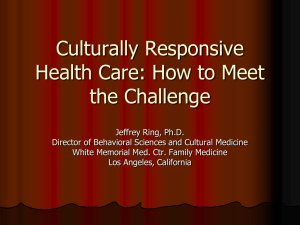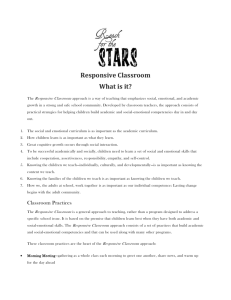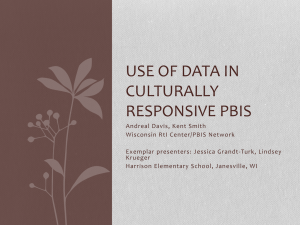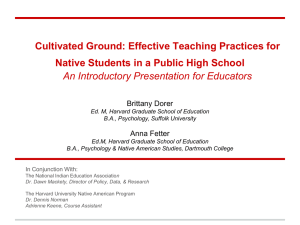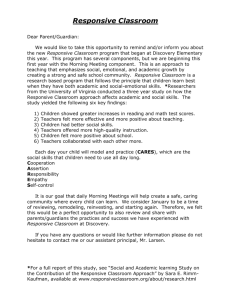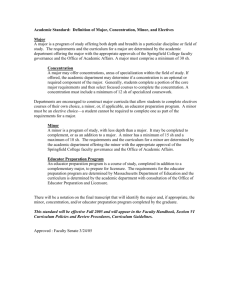Cultural Standards Alignment~All
advertisement
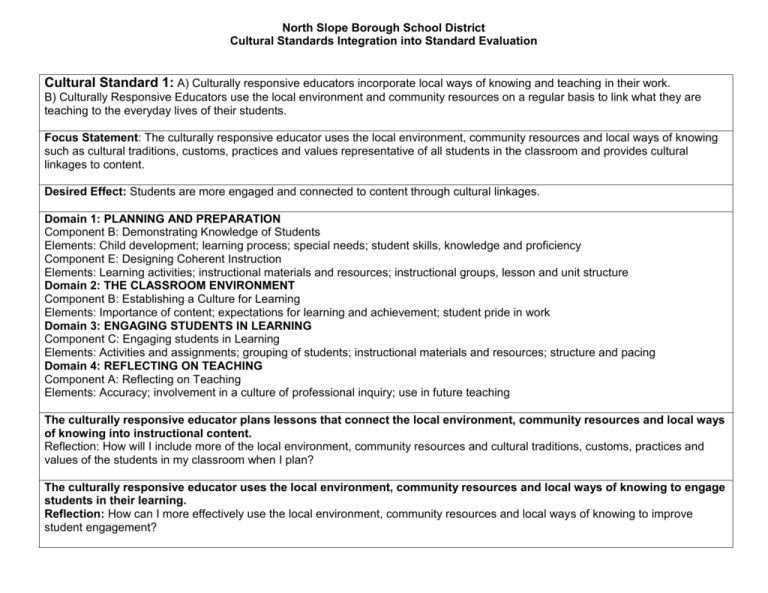
North Slope Borough School District Cultural Standards Integration into Standard Evaluation Cultural Standard 1: A) Culturally responsive educators incorporate local ways of knowing and teaching in their work. B) Culturally Responsive Educators use the local environment and community resources on a regular basis to link what they are teaching to the everyday lives of their students. Focus Statement: The culturally responsive educator uses the local environment, community resources and local ways of knowing such as cultural traditions, customs, practices and values representative of all students in the classroom and provides cultural linkages to content. Desired Effect: Students are more engaged and connected to content through cultural linkages. Domain 1: PLANNING AND PREPARATION Component B: Demonstrating Knowledge of Students Elements: Child development; learning process; special needs; student skills, knowledge and proficiency Component E: Designing Coherent Instruction Elements: Learning activities; instructional materials and resources; instructional groups, lesson and unit structure Domain 2: THE CLASSROOM ENVIRONMENT Component B: Establishing a Culture for Learning Elements: Importance of content; expectations for learning and achievement; student pride in work Domain 3: ENGAGING STUDENTS IN LEARNING Component C: Engaging students in Learning Elements: Activities and assignments; grouping of students; instructional materials and resources; structure and pacing Domain 4: REFLECTING ON TEACHING Component A: Reflecting on Teaching Elements: Accuracy; involvement in a culture of professional inquiry; use in future teaching The culturally responsive educator plans lessons that connect the local environment, community resources and local ways of knowing into instructional content. Reflection: How will I include more of the local environment, community resources and cultural traditions, customs, practices and values of the students in my classroom when I plan? The culturally responsive educator uses the local environment, community resources and local ways of knowing to engage students in their learning. Reflection: How can I more effectively use the local environment, community resources and local ways of knowing to improve student engagement? North Slope Borough School District Cultural Standards Integration into Standard Evaluation The culturally responsive educator’s classroom environment reflects cultural awareness and sensitivity of all students. Reflection: What can I do to make my classroom environment more representative of the cultures of my students? The culturally responsive educator reflects on and documents their effectiveness of using the local environment, community resources and local ways of knowing to impact student learning. Reflection: What can I do to more effectively use the local environment, community resources and local ways of knowing to improve student learning? The culturally responsive educator seeks guidance and/or mentorship to further develop knowledge about how to connect content to the local environment, community resources and local ways of knowing. Reflection: Where can I gain understanding of the local environment, community resources and local ways of knowing so I can make connections to content? Standards for Alaska’s Teachers Aligned to Pertinent Domains: 2, 3, 4, 5, 6, 8 North Slope Borough School District Cultural Standards Integration into Standard Evaluation Cultural Standard 2: The culturally responsive educator works closely with parents to achieve a high level of complementary educational expectations between home and school. Focus Statement: The culturally responsive educator includes parents/guardians when setting educational expectations for students. Desired Effect: Students know that home and school are working together to support educational expectations. Domain 1: PLANNING AND PREPARATION Component B: Demonstrating Knowledge of Students Elements: Child development; learning process; special needs; student skills, knowledge and proficiency Component E: Designing Coherent Instruction Elements: Learning activities; instructional materials and resources; instructional groups, lesson and unit structure Domain 2: THE CLASSROOM ENVIRONMENT Component B: Establishing a Culture for Learning Elements: Importance of content; expectations for learning and achievement; student pride in work Domain 4: COMMUNICATING WITH FAMILIES Component A: Communicating with Families Elements: About instructional program; about individual students; engagement of families in instructional program The culturally responsive educator collaborates with parents/guardians in the planning process to develop learning goals for students and continues to build home/school relationships. Reflection: What will I do to strengthen my relationship with parents/guardians to ensure that expectations set for students are mutually developed and understood? The culturally responsive educator uses a variety of strategies to involve parents/guardians in helping their students to review, practice and deepen content at home. Reflection: What assignments/activities can I design for my students to do at home to link and strengthen the school content to their lives? The culturally responsive educator involves the home to enhance and support the extension and application of student learning. Reflection: What strategies can I use to facilitate home involvement to support students in their application of knowledge? The culturally responsive educator engages students by communicating with homes to better understand the students’ educational needs, concerns and strengths. North Slope Borough School District Cultural Standards Integration into Standard Evaluation Reflection: How can I collaborate with parents/guardians to develop high learning expectations for students, learn about student strengths and discover areas of need or concern? The culturally responsive educator’s classroom environment encourages and engages parents/guardians to support educational expectations. Reflection: How can I create a classroom environment that supports parent/guardian contributions to the development of educational expectations for their student? The culturally responsive educator reflects on collaboration and relationships between home and school, adjusting practices as needed. Reflection: How can I improve my collaboration and relationships between home and school? The culturally responsive educator respectfully interacts and collaborates with the home to develop a shared vision of education expectations. Reflection: What can I do to build my knowledge of and demonstrate respect for my students’ cultures to improve interactions and collaborations with the home to develop shared educational expectations? Pertinent Standards for Alaska’s Teachers: 2, 3, 4, 5, 6, 7, 8 North Slope Borough School District Cultural Standards Integration into Standard Evaluation Cultural Standard 3: The culturally responsive educator recognizes the full educational potential of each student and provides the challenges necessary for them to achieve that potential. Focus Statement: The culturally responsive educator recognizes that all students of all cultures will be academically challenged. Desired Effect: All students strive for educational excellence and demonstrate pride in their culture. Domain 1: PLANNING AND PREPARATION Component B: Demonstrating Knowledge of Students Elements: Child development; learning process; special needs; student skills, knowledge and proficiency Component E: Designing Coherent Instruction Elements: Learning activities; instructional materials and resources; instructional groups, lesson and unit structure Domain 2: THE CLASSROOM ENVIRONMENT Component B: Establishing a Culture for Learning Elements: Importance of content; expectations for learning and achievement; student pride in work Domain 3: ENGAGING STUDENTS IN LEARNING Component C: Engaging students in Learning Elements: Activities and assignments; grouping of students; instructional materials and resources; structure and pacing Component D: USING ASSESSMENT IN INSTRUCTION Elements: Assessment criteria; monitoring of student learning; feedback to students; student self-assessment and monitoring of progress. Domain 4: COMMUNICATING WITH FAMILIES Component A: Communicating with Families Elements: About instructional program; about individual students; engagement of families in instructional program The culturally responsive educator uses a planning process that incorporates strategies that academically challenge each student while honoring his/her cultural identity. Reflection: What will I do to better understand the full potential of each of my students in order to challenge their learning while honoring their cultural identity? The culturally responsive educator provides cultural learning opportunities that help challenge all students to connect to new content. Reflection: How will I help each student utilize their culture so they connect to the content in a meaningful way? North Slope Borough School District Cultural Standards Integration into Standard Evaluation The culturally responsive educator designs learning experiences that challenge all students to practice and develop fluency in their understanding of content through a cultural lens. Reflection: What can I do to ensure that all students of all cultures are challenged to practice and develop fluency in their understanding of content through cultural connections? The culturally responsive educator provides support and guidance to challenge all students to use higher order thinking skills when applying content to their lives. Reflection: How can I guide and support all students to demonstrate higher order thinking skills when applying the content to their lives? The culturally responsive educator’s engages and challenges all students through a variety of cultural activities/assignments. Reflection: What can I change in my approaches, strategies and content to keep all students consistently challenged and engaged? The culturally responsive educator creates a warm, safe and caring classroom environment where all students acknowledge their cultural heritage and are encouraged to strive for educational excellence. Reflection: How can I improve my classroom environment so that all students strive for academic excellence and show pride in their culture? The culturally responsive educator reflects on student performance without cultural bias based on assessments to identify areas for academic challenges. Reflection: How do I differentiate my instruction to support diverse student learning needs? The culturally responsive educator models respect and acceptance of all students of all cultures while challenging each student to strive for academic excellence and culture pride. Reflection: What will I do to develop and/or maintain respectful interactions and cultural sensitivity with all of my students to encourage them to strive for academic excellence and culture pride? Pertinent Standards for Alaska’s Teachers: 2, 3, 4, 5, 6, 8
